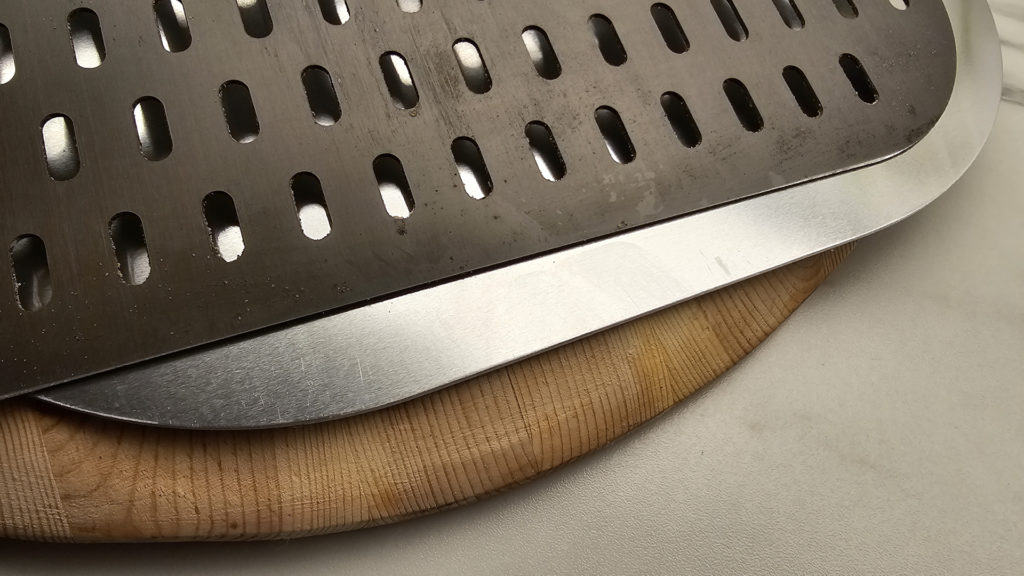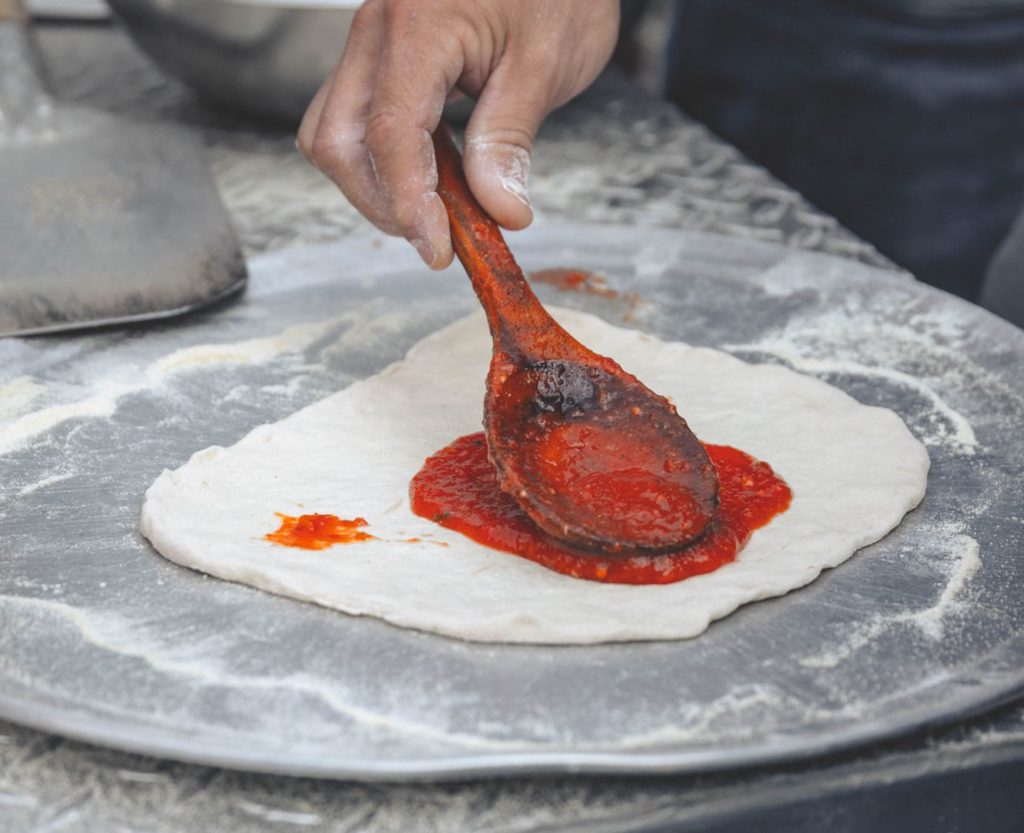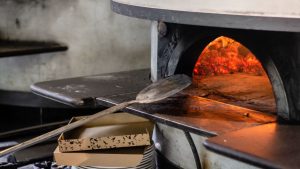Deciding between a wood or metal
Choosing the peel that best suits your specific pizza-making needs is crucial. The right peel makes the difference between a seamless, enjoyable pizza night and a frustrating, sticky mess. I’ve learned this the hard way through my nearly two decades of pizza-making.
In this article, we’ll dive into the differences between wood and metal pizza peels. We’ll explore the advantages and disadvantages of each type and help you match the perfect peel to your pizza style and oven. My goal is to ensure you find the peel that’s the ideal fit for you!
Key takeaways: wood vs metal pizza peel
Wooden pizza peel
- Pros: Less sticking, easy to use for beginners
- Cons: Requires more maintenance, can be thicker making it harder to slide under the pizza,
- Best for: Transferring raw pizzas to the oven.
- Recommendation: Pizza Royale Bamboo Pizza Peel
Metal pizza peel
- Pros: Durable, light, thin edge for easy handling, simpler to clean.
- Cons: More dough striking, unless you use a perforated peel
- Best for: Turning and retrieving pizzas from the oven
- Recommendation: G.a Homefavor 12″ Perforated Pizza Peel

The importance of using the right peel
Using the right
The two most common problems you’ll encounter with pizza peels are:
- Peel sticking: If your pizza dough sticks to the peel, it can be tricky to transfer it smoothly into the oven.
- Peel Thickness: A peel that is too thick can make it challenging to handle and move your pizza with precision.
Selecting a peel that doesn’t suit your preferred pizza style and preparation method can lead to issues.
Wooden peels, being thick and sturdy, naturally minimize sticking. In contrast, metal peels, with their thinner design, slide under pizzas more easily but also allow for more sticking of the pizza base.
Pizza peels in Naples
A few years ago I visited Naples while doing pizza research, and noticed that some pizzerias used a wooden peel, while others used perforated pizza peels made from metal. In one of the restaurants, I talked to the pizzaiolo and asked about this. He told me that many pizza makers in Naples still use traditional wooden peels, but more and more are switching to perforated peels due to their durability, lower weight, less maintenance, and longer lifespan.
When I got back home, I bought my first perforated
Wooden pizza peels
The wooden
The main downside is their thickness, which makes retrieving your pizza from the oven more challenging. Wood also requires more maintenance to prevent warping and cracking.
Metal pizza peels
Metal pizza peels often come in aluminum or stainless steel. These peels are durable, yet thin, making it easy to slide the peel under the pizza. This design makes them excellent for turning and retrieving pizzas from the oven.
The main drawback is that raw pizza dough tends to stick to metal more than it does to wood. This can make launching pizzas tricky.
Perforated metal peels
Perforated metal peels address the sticking problem with a design that features small holes throughout, reducing surface contact and allowing excess flour to escape. This feature ensures a crispier pizza base and is particularly beneficial for Neapolitan pizzas, which require minimal time on the peel before being placed in the oven.
These peels are an innovative take on traditional metal pizza peels, and their popularity is growing. The on the peel holes serve three main purposes:
- Reduce sticking: By allowing airflow and reducing the surface area in contact with the pizza, the holes make it significantly easier for the pizza to slide off compared to a regular metal peel.
- Remove excess flour: The holes help shake off any excess flour from the pizza base, preventing it from burning in the oven.
- Allow steam to escape: When retrieving the pizza from the oven, the holes let steam escape, which can help keep the crust crispy.
There is one caveat though. You shouldn’t leave a pizza for long on a perforated peel, especially a heavy pizza with a lot of toppings. Over time, the dough can sink into the holes. This makes launching the pizza even harder than with a sticky metal peel. Therefore, a perforated peel is ideal for Neapolitan pizza. This is where you prepare the pizza on the counter and slide it onto the peel just before it goes into the oven.
I was skeptical when I first saw a perforated metal peel. But the first time I used it, the lightness of the peel and the effortless launch were revelations. It changed my pizza game forever.
Considerations when choosing a peel
Choosing the right peel means thinking about your pizza style, the type of oven you use, and what feels easiest for you to handle.
I once had a deep discussion with a fellow pizza lover about our peel preferences. It was then I realized that picking a peel is a personal journey, akin to choosing a wand in a world of magic. That conversation inspired me to help every pizza enthusiast find their ideal peel.
What to use the peel for
There are three main tasks you use a
- Moving the pizza into the oven
- Turning the pizza in the oven (especially relevant for pizza ovens)
- Retrieving the pizza from the oven
Each task requires different peel properties.
Wood is the best choice for launching pizza
The key when moving your pizza into the oven is to prevent peel sticking. You don’t want your pizza stuck to the peel during launch. A disaster is a pizza stuck halfway, with toppings falling off. Also, the peel needs to be large enough for your pizza. Any part of the pizza hanging off the edge will cause issues.
A metal turning peel is best for turning your pizza in the oven
For turning the pizza, the peel must be thin and manageable. This ensures you can slide the blade under the pizza easily. There are special turning peels designed for this.
A thin metal peel is best for retrieving the pizza from the oven
To retrieve the pizza, you’ll want a thin yet sturdy peel. It should slide under the crust smoothly, allowing you to lift the entire pizza from the hot oven.
No peel is perfect for every task
Different peels are better at different tasks. If you’re aiming for one peel that can do it all, especially as a beginner, you’ll need to find a good compromise.
The type of pizza you want to make
Different pizza styles call for different approaches, which will influence your choice of peel.
Some pizzas, like the Neapolitan, are topped on the counter and then slid onto the peel. Others, such as the New York style, are assembled directly on the peel.

Transferring the pizza to the peel: Neapolitan style
Neapolitan pizza is stretched and topped on the counter before it’s slid onto the peel. Using this approach means the pizza will stay on the peel for just a few seconds, and sticking is less of a concern. This style of pizza is also lighter due to fewer toppings, reducing the risk even further.
When sliding the pizza over the edge, the peel must be thin to avoid damaging the delicate dough. A thin peel also reduces the risk of messing up the pizza when launching it into the oven. So for Neapolitan style metal pizza peels are good.
Building the pizza on the peel
For most pizza styles, assembly occurs directly on the peel, meaning the raw pizza dough rests there longer during topping. In these cases, a peel with good non-stick properties is crucial to prevent the dough from adhering to the peel.
Pizza making experience
Your pizza making experience also matters. The best peel for an experienced pizzaiolo might not be the same as for a beginner making their first pizza.
For beginners, wood is often the best choice. The main challenge for new pizza makers is launching the pizza into the oven, and wood is more forgiving for this task.
For professional pizza makers, a metal peel typically works better. In a professional setting, speed is crucial, and the pizza doesn’t stay on the peel long enough for sticking to be a major issue. A lighter peel is also preferable for those working with it throughout the day.
Weight
Wooden pizza peels are generally heavier than their metal counterparts. This is particularly true for wooden peels designed for large wood-fired ovens, which need a long handle. At home, the peel’s weight may not be a big concern. However, in a professional setting where pizzas are made all day, a lighter peel makes a huge difference.
Type of oven
No matter the oven you use, wood-fired, electric, or home oven, both wood and metal peels will work.
Durability
Durability is also important to consider, especially if you’re planning to make a lot of pizza (like me).
Wood has a shorter lifespan, especially if not properly maintained. It can warp or crack over time and also absorb moisture and odors from sauce and oil. For home use, this might not be a big concern.
Metal peels are generally more durable and resistant to warping. They are also less affected by moisture but can bend or dent under extreme use.
Price
Pizza peels range in price from around $20 to hundreds of dollars.
Wooden peels are usually less expensive than metal peels. However, they may not last as long. At home, the price difference might not be a major factor. Most home pizza makers won’t go through several peels in a year.
Maintenance and cleaning
All peels need maintenance and cleaning, but some require more effort than others.
Wooden peels need more care. They should be oiled regularly to stay in good shape. Cleaning them can be tricky because they soak up sauces, oils, and other stains. Water can damage wood, leading to warping, so soaking or dishwashing is a no-go.
Metal peels are simpler to clean and maintain. Some are even dishwasher-safe. Just watch out for rust, as certain metals can rust if left wet.
When wood is the best choice
Choose a wooden
For beginners, a wood peel is user-friendly. The lower chance of the dough sticking eases the learning curve. You can assemble your pizza right on the peel, a simpler method than transferring it. Plus, wooden peels are often more affordable, making them a great starting point for new pizza chefs.
When metal is the best choice
Metal pizza peels are best for turning and retrieving pizzas from the oven.
They’re particularly good for Neapolitan pizzas, which are light and spend very little time on the peel, minimizing any issues with sticking.
For professional pizza makers, metal peels are a smart pick. They’re lightweight and easy to handle, crucial for busy kitchens. Durability, ease of cleaning, and low maintenance are bonuses that make metal peels a solid investment for the long haul.
Wood or metal for Neapolitan pizza
For Neapolitan pizza, a perforated metal peel is the best pick.
This style of pizza, known for its thin and soft crust, benefits from the peel’s sleek design. Since you’ll prep the pizza beforehand, it won’t stick to the metal surface. The peel’s thinness helps with the gentle handling required for this delicate pizza type. Additionally, metal peels are more durable and have lower maintenance compared to their wooden counterparts, making them a practical choice for Neapolitan pizza enthusiasts.
Perforated Pizza Peel – the Best of Both Worlds!
If you just want one
A perforated peel gets rid of more flour from the pizza dough. This is a huge benefit because the extra flour will burn in a hot oven, and create a burnt flavor.
And there is more! A perforated
One of the main benefits is that it gets rid of excess flour. The carrying also surface provides less friction, between the pizza and the peel, in addition to a lighter weight than a regular metal peel.
Perforated pizza peels tend to be slightly more expensive than wood and metal peels, starting at around 50 dollars. But it’s still the cheaper option since you only need one peel!
G.a Homefavor 12″ Perforated Pizza Peel – The best option for home use
The best perforated
This lightweight premium, anodized aluminum peel features a balanced 12x14-inch blade for effortless handling and a perforated surface to reduce sticking.
The Komista
G.a Homefavor 12″ Perforated
The Best Wooden Pizza Peel
When you’re looking for a wooden
What Is the Best Wood for a Pizza Peel ?
A hard type of wood is the best material for a wooden
Pizza Royale Bamboo Pizza Peel
In my opinion, the best wooden
A high-quality wooden pizza peel, made from bamboo and capable of fitting a 12-inch pizza, comes with a 180-day guarantee.
It has a smooth surface that allows the pizza to slide both on and off easily. If you like me have experience with pizza that sticks to the peel, you know the frustration. There is nothing worse than a pizza night ruined because you can’t get the pizza off the peel! With a high-quality bamboo peel, you’ll never have to deal with that again.
Bamboo might not be a traditional choice, but it’s an extremely durable material that requires little care. It’s also harder than most types of wood and is therefore scratch-resistant. Pizza Royale’s Bamboo
The Best Metal Pizza Peel
The best metal
Featuring an anodized aluminum blade and a solid basswood handle, the New Star Foodservice Aluminum Pizza Peel is ideal for daily use. The thin aluminum blade makes it easy to slide the peel under any pizza, ensuring easy launching and retrieval!
Wooden peels can be frustrating because they are thick and bulky and nearly impossible to slide under the pizza. They are also hard to clean, and tomato sauce stains never go away… Luckily a quality metal peel can solve this problem.
The Skyflame Kitchen Supply Aluminum
This is a US-made, budget-friendly, quality peel with a nice aluminum finish, and is my top metal
Conclusion
Choosing between a wood and metal
Wood peels are traditional and less likely to stick, making them ideal for launching pizzas and suitable for beginners or home chefs. Metal peels, especially perforated peels, are best for precision tasks like turning and retrieving pizzas, thanks to their thin and durable design. When deciding, consider what’s most important to you in the pizza-making process, whether it’s the ease of launching or the precision in handling, to ensure the peel enhances your experience and the final pizza.
Check out our pizza peel buyer’s guide to find the right peel for you.
Related
- Is Your Pizza Dough Too Dry? Here is How to fix it! - June 10, 2024
- The Ultimate Guide to the Pizza Dough Windowpane Test - June 8, 2024
- The Ultimate Guide to Autolyse Pizza Dough - June 7, 2024




